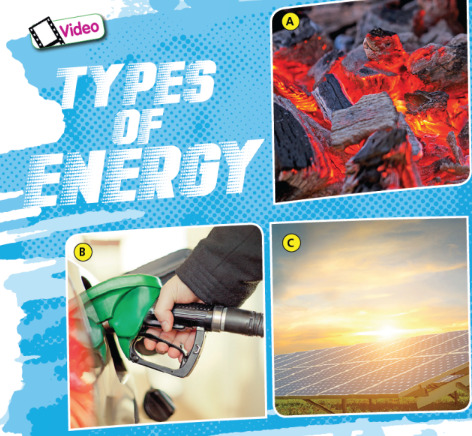Đừng bỏ lỡ những tính năng hấp dẫn của Baitap365.com
Tiếng Anh 7 Going Green 3. Types of energy
1. Look at the pictures. Which energy resources can you see: coal? oil? Natural gas? petrol? Wind power? Solar power? hydro-electric power?
Bài 1
1. Look at the pictures. Which energy resources can you see: coal? oil? Natural gas? petrol? Wind power? Solar power? hydro-electric power?
(Nhìn vào những bức tranh. Bạn có thể nhìn thấy những nguồn năng lượng nào: than đá? dầu? Khí tự nhiên? xăng dầu? Năng lượng gió? Năng lượng mặt trời? thủy điện?)
• hydro-electric power: thủy điện
• fossil fuel: nhiên liệu hóa thạch
• organic material: chất hữu cơ
• geothermal source: nguồn địa nhiệt
• run out: cạn kiệt
• chemical: hóa học
• convert: chuyển đổi
• generator: máy phát điện
• turbine: tuabin

Bài 2
2. Which of the energy resources in Exercise 1 are renewable? non-renewable? Read to check.
(Tài nguyên năng lượng nào trong bài tập 1 có thể tái tạo được? không tái tạo được? Đọc để kiểm tra.)
Coal, oil and natural gas are fossil fuels. Organic materials formed them over millions of years. Fossil fuels are non-renewable. We cannot replace them. When we burn fossil fuels, the chemical energy inside them becomes heat and light, but burning fossil fuels produces pollution.
Renewable energy resources include wind, waves, sunlight and geothermal sources.
These resources will not run out and do not produce pollution. Solar energy comes from sunlight. Nowadays we use solar cells to convert sunlight into electricity and solar panels to heat up water. We also use moving water such as waves to turn underwater generators, and turbines to generate electricity from the wind. We should produce more of our electricity by using renewable energy resources so that fossil fuels won't end. We can also save energy. We can walk to school, wear warmer clothes and turn off lights and appliances when we don't need them.
Bài 3
3. Answer the questions.
(Trả lời các câu hỏi.)
1. What are fossil fuels?
2. Why is using fossil fuels not good for the environment?
3. What are renewable energy resources?
4. Why should we use renewable energy resources to produce electricity?
5. What can we do to save energy?
Bài 4
4. What can we do to save energy? Discuss. Think about home heating and cooling, home appliances and water. Use your answers to prepare a leaflet. Add pictures.
(Chúng ta có thể làm gì để tiết kiệm năng lượng? Bàn luận. Hãy nghĩ về hệ thống sưởi và làm mát nhà, thiết bị gia dụng và nước. Sử dụng câu trả lời của bạn để chuẩn bị một tờ rơi. Thêm hình ảnh.)
WAYS TO SAVE ENERGY
Switch off the lights when you leave a room. Always turn off your TV or other devices, don’t leave them on standby. The more electricity we use the more fossil fuels we burn.
Turn off the tap while brushing your teeth. Take a shower instead of taking a bath. Water is important and we shouldn’t waste it.
(CÁC CÁCH TIẾT KIỆM NĂNG LƯỢNG
Tắt đèn khi bạn rời khỏi phòng. Luôn tắt TV hoặc các thiết bị khác, không để chúng ở chế độ chờ. Chúng ta càng sử dụng nhiều điện thì càng đốt nhiều nhiên liệu hóa thạch.
Tắt vòi trong khi đánh răng. Hãy tắm vòi hoa sen thay vì tắm bồn. Nước rất quan trọng và chúng ta không nên lãng phí nó.)
Bài 5
5. What is the future energy? Collect information. Tell the class.
(Năng lượng tương lai là gì? Thu thập thông tin. Nói cho cả lớp.)
Mẹo tìm đáp án nhanh
Search Google: "từ khóa + baitap365" Ví dụ: "Bài 5 trang 13 SGK Vật lí 12 baitap365